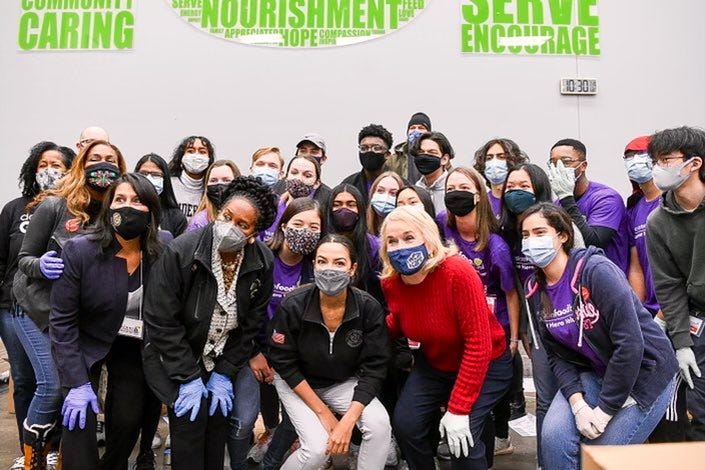Ask Michael: How do I know what my “brand” is?
Plus: A new book on the value of humor, the reinvented power ballad and my next pair of brunch boots.
In this week’s “Ask Michael”: You wrote about the importance of a distinct brand last week but how do I know what my “brand” is?
Your brand is what people say or think about you when you’re not around. It’s a fool’s errand to attempt to dictate your brand to anyone. No matter how on-point your work is, how professional your business is or how well-meaning your intentions are, your brand image is ultimately determined by the people who interact with your business and the products and experiences it delivers. But you can influence how people perceive your work. That’s where branding — the process of engineering an experiential identity that entices your people to notice, purchase and share your work — comes in.
Because the value of your work isn’t that you write articles for a blog, take pictures in natural light, teach fitness classes to time-strapped professionals, share audio or video files on social platforms, strategize campaigns with corporate clients, perform art onstage, organize movements for global change, record music in a studio, code a website or develop software for desktop or mobile devices. Anyone with an internet connection and enough financial and creative wherewithal can not only learn to do all of the above at a high level but also present themselves as a superior alternative to your dream customers and super fans.
I love how author Seth Godin puts it: “If I’m buying wheat by the ton or coffee by the pound or bandwidth by the GB, I don’t have any expectations other than the [specifications]. Get me exactly what I got yesterday, faster and cheaper, and I’ll pay you for it. How do we that brands like Verizon and AT&T are essentially worthless? Because if we switched someone from one to the other, they wouldn’t care.”
Not only is branding the bridge between your creative work and the marketing and sales activities you perform to get people to pay attention to and pay for it, but it’s also the wild card that can’t be duplicated or personified by anyone else. When you invest in branding, you can freely enter and leave new or stale product categories without recourse and your competitive alternatives will be unable to commodify your creative work.
Ask Michael is The Supercreator’s weekly Q&A dedicated to minimizing the guesswork, overwhelm and frustration from your creative life. Reply to this email or post a comment with your question and it may be featured in a future issue.
What I Wrote About This Week
I’m unsure if the solution is as simple as “hire Black creators to work with Black talent,” which the common refrain from online armchair fashion editors though. For one, Black people aren’t a monolith and creativity, as Nasr alluded to Givhan, is comprised of more than racial identity. (Remember: Nasr identifies as a person of color and the internet still lambasted Megan Thee Stallion’s cover.) I’m interested in telling stories from the Black experience and those narratives are often universal and not just about the Black experience. Most creators of color I know share a similar point of view. Also, it’s reductive for Black people to be expected to work across the spectrum of identities while white people are unaccountable for adapting their skills to capture Black excellence. And no matter how talented the pool of Black creators maybe, we’re often no match for the systemic and institutional barriers that exclude us from entering the pipeline that nurtures, develops and hires the mostly white creative teams that produce the media we consume. Unless we fundamentally transform who sits at the table and sets the menu, we’ll continue to view Black creativity as an opportunity to signal white virtuousness and not as the economic, cultural and political asset it is.

We should think beyond crisis fundraising to rebuild our social safety net:
I’m aware that it’s rich for me to critique crisis crowdfunding when my basic needs are covered and my family came out of the storm in one piece. Most people who need relief are often unconcerned with where it comes from. And I respect all the people who donated to fill in the gap left by the political ineptitude and cruelty of our elected officials. But this approach to caring for our neighbors is reactive as if experience suggests we need a smaller social safety net instead of one that’s more robust. It maintains the status quo of those with means dictating to those without which causes and organizations are worthy of resources. And it gives the GOP cover from accountability for decades of policy failures at every level of government. Crisis fundraising is akin to applying a bandaid to a wound that needs stitches. Plus, the unpredictability of crises — be they natural, economic or cultural — make it impossible to anticipate how the variables of each circumstance will ultimately play out. It’s better, as they say, to stay ready so we don’t have to get ready.
I was also struck by the terrible analogy put forth by Clegg to justify his company’s position: “It’s like forcing car makers to fund radio stations because people might listen to them in the car — and letting the stations set the price.” Um, what?! For starters, the auto industry is regulated, unlike most tech companies. These rules affect how cars look, how parts are designed and which safety features are included — factors that influence the overall performance of a vehicle. And these regulations also increase production costs and limit how cars are sold and marketed. Facebook and ad-supported social apps, on the other hand, collect the data it feeds into its targeting algorithms for free and keep 100 percent of the revenue. The auto industry also didn’t disrupt radio stations the same way social apps upended the digital ad market. Let’s not forget too that Facebook has had a decade-plus head start to consolidate incomparable wealth and influence before consumers and politicians finally started to listen to the critiques of its products from journalists and activists. A Facebook spokesperson did not respond when asked if it agreed with Clegg’s assertion.
Thoughts and Things

This book is a permission slip to laugh a little more at work and in life.
There could be an upside to smoking weed that doesn’t get you high.
This sleek storage pouch is the perfect home for my face masks.
I always wondered how people named Rona felt about the ‘Rona.
My mind has been stuck on these western-inspired brunch boots for weeks now.
Follow-Up
In last week’s “From The Archive,” I mentioned that Gimlet Media — the publisher of the Reply All podcast and “The Test Kitchen,” a new miniseries about the toxic culture at Condé Nast’s Bon Appétit — found itself embroiled in its own workplace scandal. Today, Reply All co-host Adam Goldman announced the cancellation of the series and apologized for the show’s “editorial failure” in throwing stones from a glasshouse. “We now understand that we should never have published this series as reported,” he said.
From The Archive

“Thank God I’m not the only one who dislikes Amazon’s new ads” (published 12/9/20) — As part of a campaign to bust up a unionization effort by employees in one of its Alabama warehouses, Amazon is touting its $15 minimum wage as proof that workers are better off than reports suggest. But as Edward Ongweso Jr at Motherboard notes, warehouse jobs typically pay much more than $15. “Amazon is pulling a trick where it appears to be paying more than its competitors, but the job in question is not the same as those it’s being compared to when we talk about Walmart.” Another trick that Amazon loves to pull? Gaslighting workers with the dangerous notion that work is your family:
These harmful ideas are related to the corporate and consumer expectations that creative professionals should accept less value because some of us enjoy the labor as much as the fruits. It’s what sustains the myth of the starving artist that socializes consumers to view professional creators who possess the audacity to put a price tag on their creative work as sellouts and grifters. This same mindset is what fuels the belief that warehouse workers should be content with the status quo because, um, look how fucking fun it is to work at Amazon with your family. Where’s your gratitude, you monster?! Beyond the smoke and mirrors of these ads lies the truth though: Amazon is a for-profit company worth more than $1.5 trillion. It places immense pressure on its warehouse workforce to pick, pack, ship, and deliver millions of items with increasing speed and precision that feeds the mindless consumerism our economy requires and likely leaves little room for the laughing, dancing and flattery we saw in those ads. And what’s the point of being in a family if you can’t be honest?
One More Thing

Next time someone tells you wealth inequality isn’t worsening, just show them this list of the 100 most overpaid CEOs, which shows some executives collecting more than 1,000 times the income of a median company employee.




